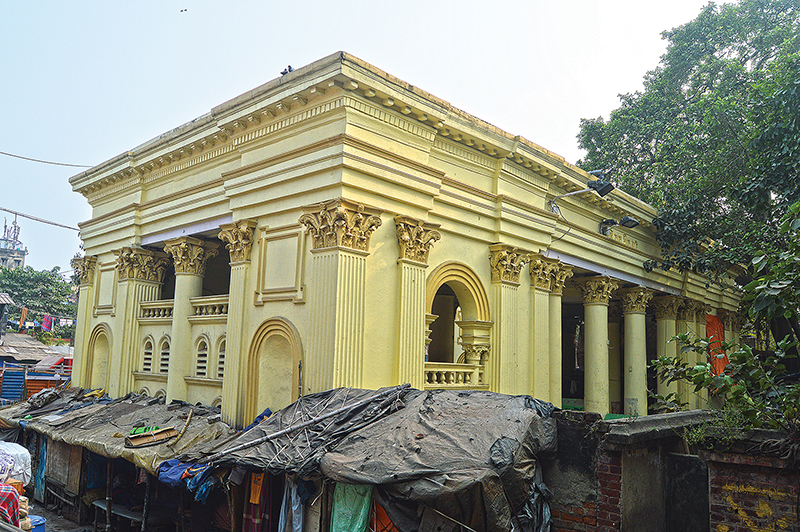
Across the gawky gulleys leading to the Ganges, tethered to timelessness are a series of quays dotting Kolkata’s river banks. The banks, whether plush or pitiful, daunting or dismaying, always have a story to tell. Standing out amidst all the chaos and confusion is the sunset yellow quay, shining with optimism and happiness – its golden yellow pillars boasting the legends of a glorious past and the promise of a positive future. Hail the Mutty Lall Seal Ghat for creating its own sunshine.

Route
Move northward by the Strand Road. Turn left onto Strand Bank Road from the Nagareshwara Temple on right. Cross the Circular Railway Line and turn right to move northwards to find the restored sunset yellow Mutty Lall Seal Ghat on your left.
The Ghat
Christened after Babu Moti Lal Seal, one of the richest and most virtuous of the Babus of the then Calcutta, the Mutty Lall Seal Ghat was erected as a bathing ghat by Seal himself, on the bank of the River Hooghly somewhere towards the end of the 19th century, as an act of benevolence.
The ghat stands on beautiful, ornate Corinthian columns that support the parapet. The light yellow columns decorated with carved acanthus leaves painted golden are beguiling. The majestic construction of this ghat can easily be distinguished from all the others in the line, owing to this very special architecture – a unique feature of this ghat.

A typical bathing ghat, Mutty Lall Seal Ghat is otherwise compact in construction. The ghat has been restored by Kolkata Port Trust, who have painted it yellow and reconstructed some of the sculptures of the columns highlighting its Greek style of architecture.
A low wall has been built inside the colonnade that runs along the stairway descending down the river. The wall with flowers painted in bright colours, has been built to separate the ladies’ section from the men’s, which is about a third of the men’s area. There is a Shiva temple, built on a much later date, on the ghat.

History
Moti Lal Seal was the son of a cloth merchant, Chaitanya Charan Seal. He had worked in Fort William, where he was involved in the supply of essential commodities for the British Army.
Moti Lal commenced his business career in humble fashion by selling bottles and corks to Mr. Hudson – a prominent importer of beer. He traded in cowhides and was the founder and promoter of the first indigo mart.
He also became a landed property speculator as well as merchant in indigo, silk, sugar, rice, saltpetre to Europe and importing of iron and cotton-piece goods from England. Under his influence, the then Oriental Life Insurance Company, the first life insurance company on Indian soil, accepted the task of underwriting Indian lives. He was among the founders of the Bank of India apart from being on the board of the Agricultural and Horticultural Society of India.
Seal is best remembered as the donor of an extensive tract of land, then valued at INR 12,000 and on which the Calcutta Medical College was built, to the then British Government. In 1842, Seal also opened the Mutty Lall Seal Free College. This college was to provide for the education of the Hindus to enable them to occupy posts of trust and emolument in their own country. Moti Lal Seal also founded an 'alms house' at Belgharia where on an average five hundred people were fed daily. This is still operational.

Life at the Ghat
While Kolkata Port Trust has done a brilliant job of restoring this magnificent piece of architecture to its former glory, the ghat is breathing heavy under the uncaring, inconsiderate behaviour of the locals. The grand facade is a great landmark to have, yet is almost obscured from public view. Once a bustling bathing ghat, today, this dainty edifice is struggling to assert its identity amidst the heavy-duty, unappealing trucks guarding its view. The colonnade is nothing but a storehouse for freight. The stench of human faeces and rotten organic waste overpower the riverside, making it impossible for bathers to take a dip in the holy waters.
Let us hope that the quay may one day, once again, become the same familiar bathing ghat, swarming with bathers in celebration of life! May this beautiful monument not be mistaken for one of the warehouses of the Strand Bank Road! May the ignorant porters and paupers develop the sensitivity not to convert this phenomenal work of art into a dumping ground! The gloom in the air is palpable for all the die-hard Kolkata fans who have already visited or are planning to explore this classy quay. And if you are still struggling to fight the murky sense of decay, then think of the old saying, “When the present is full of gloom, the past becomes a haven of refuge that provides relief and inspiration.”